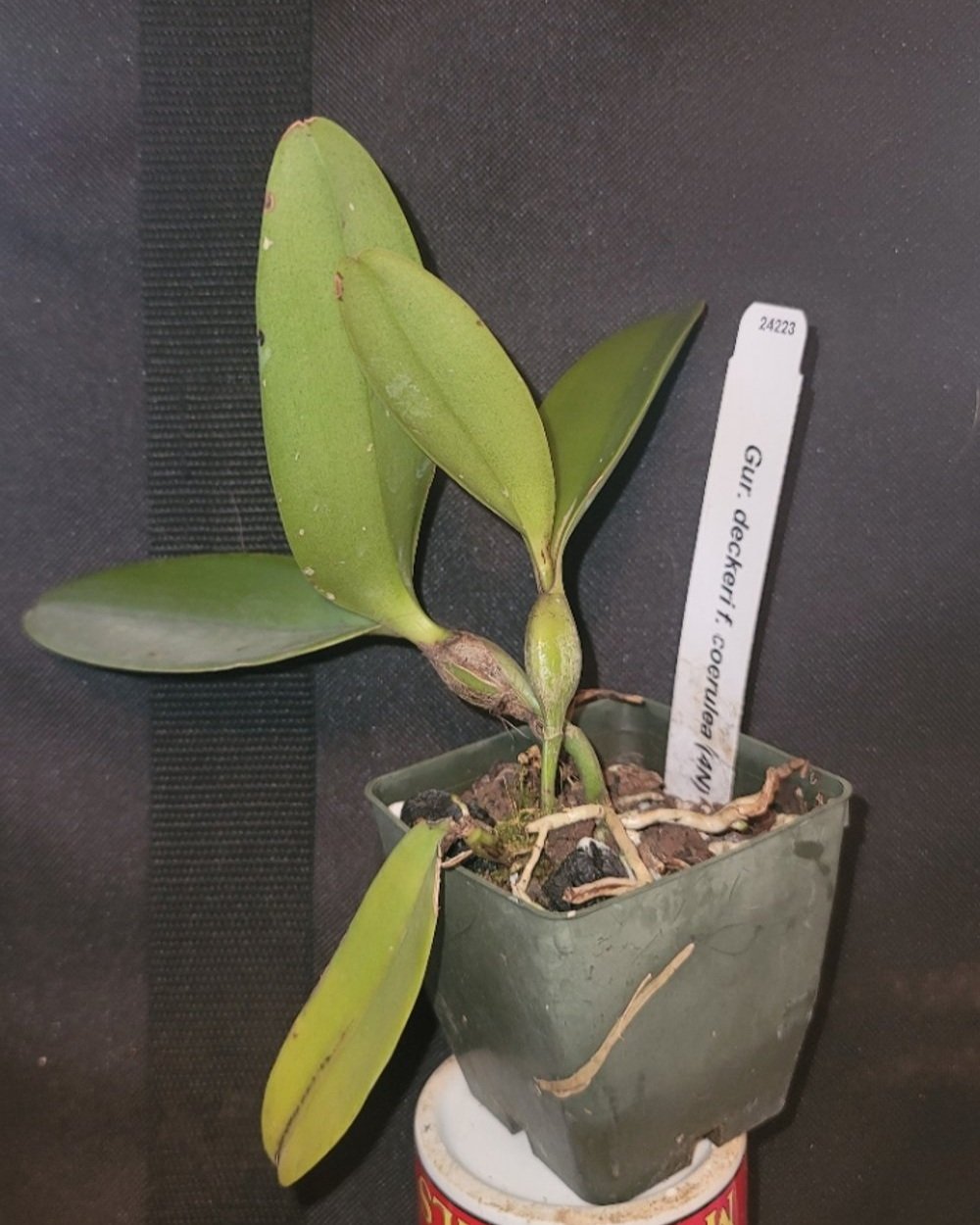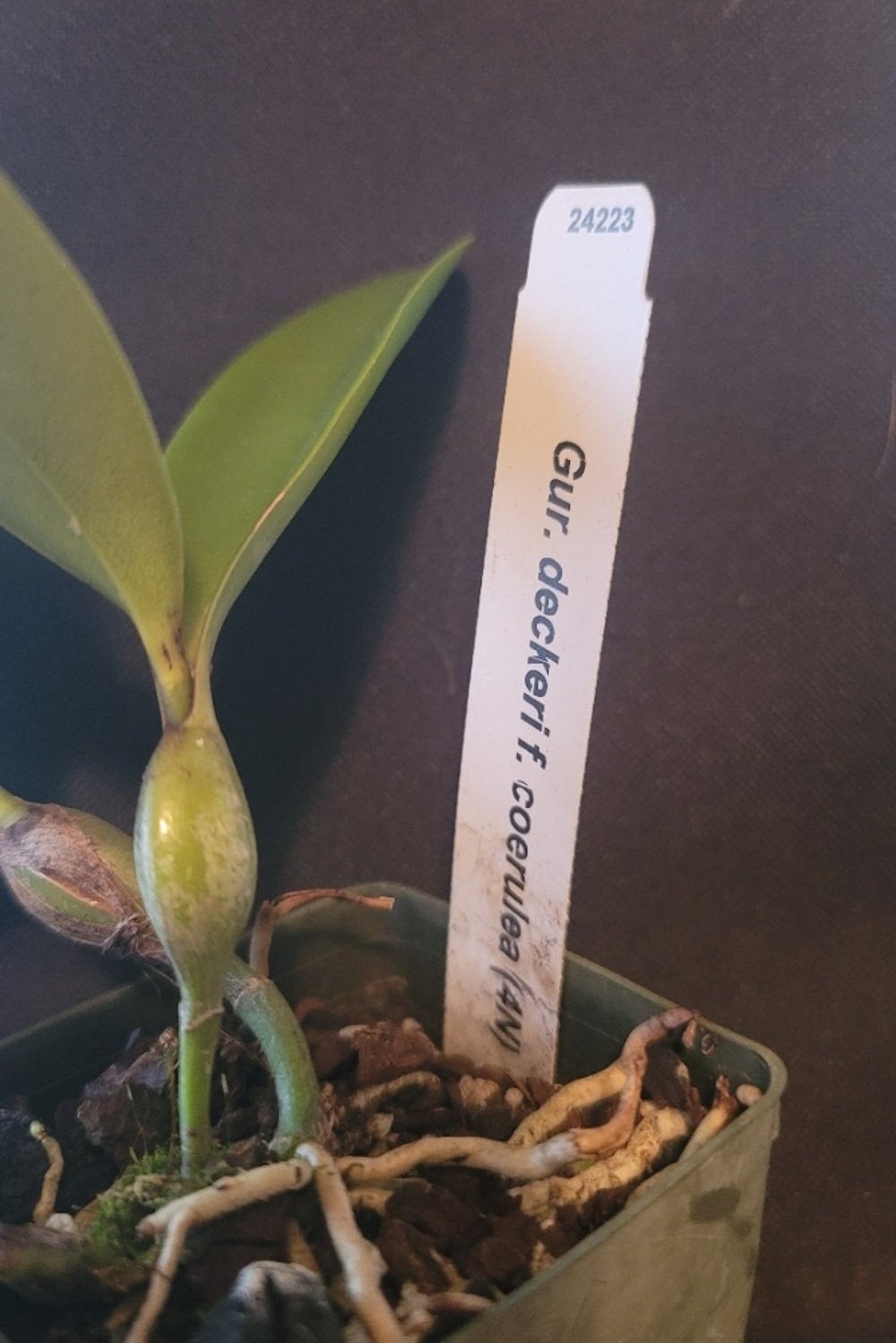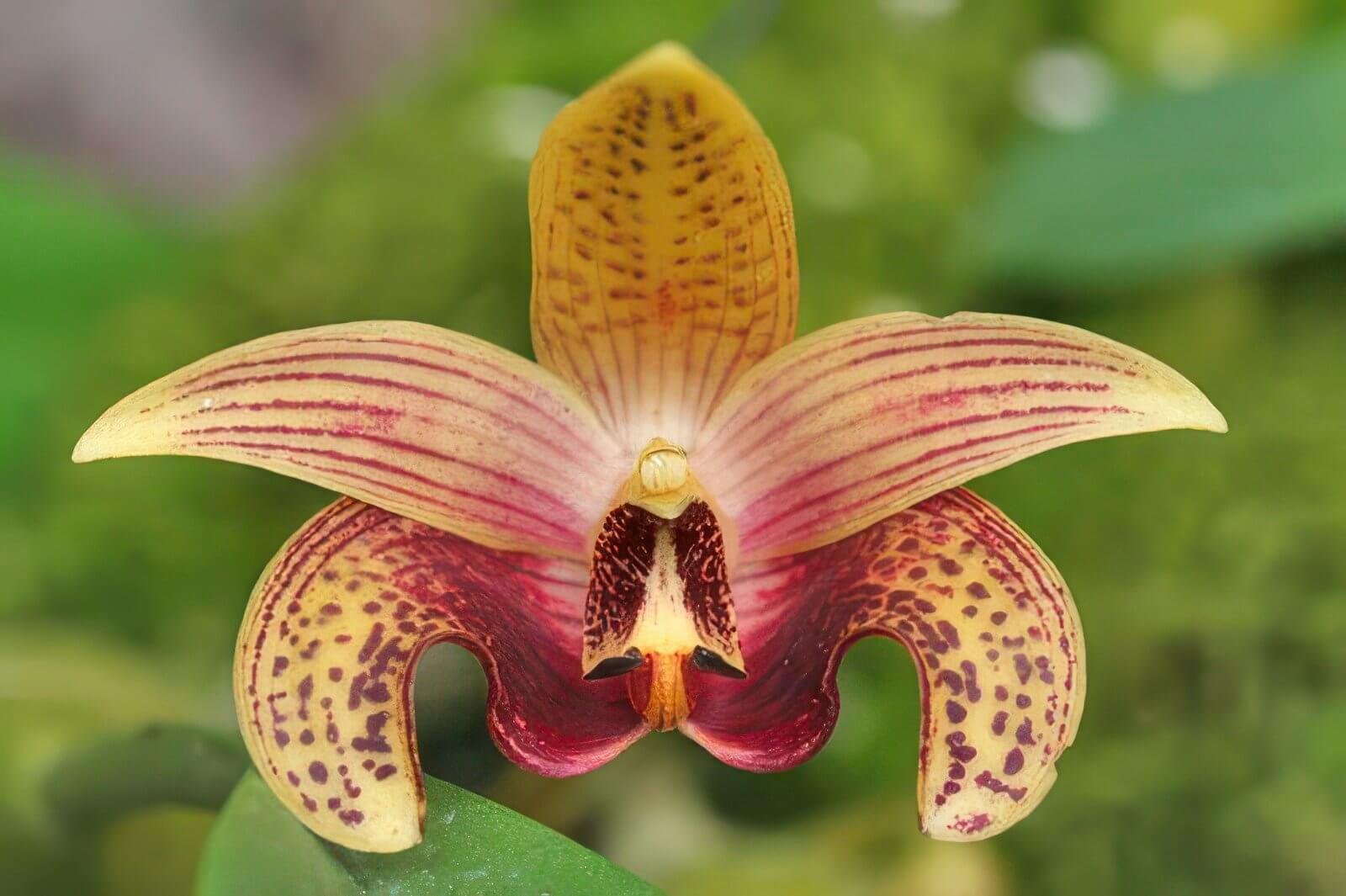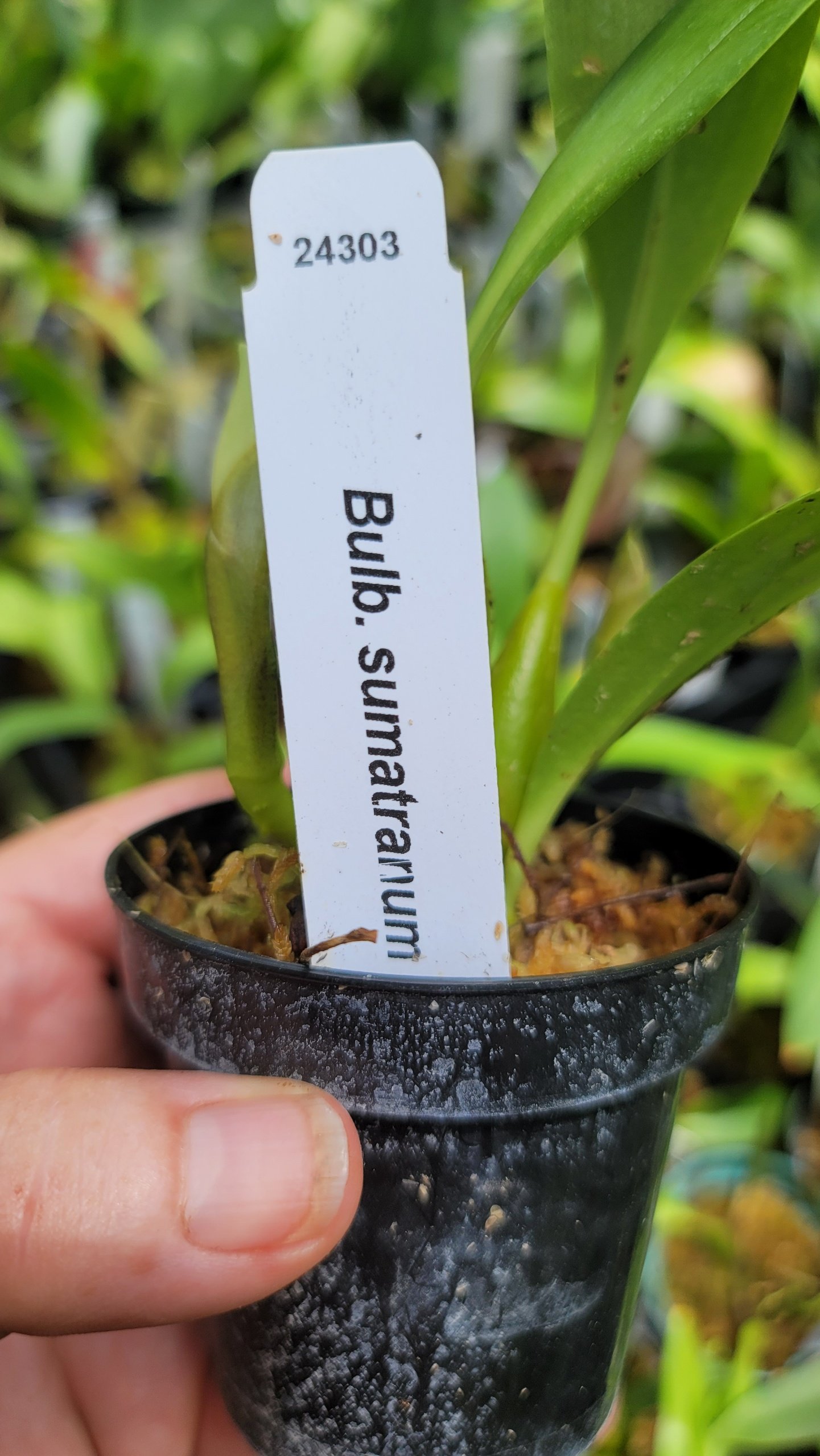 Image 1 of 3
Image 1 of 3

 Image 2 of 3
Image 2 of 3

 Image 3 of 3
Image 3 of 3




Guarianthe deckeri f. coerulea
There’s been taxonomic debate surrounding Guarianthe deckeri (sometimes treated as Guarianthe skinneri var. deckeri) and its distinction from Guarianthe skinneri. While many modern sources still synonymize them under G. skinneri, some taxonomists and growers elevate deckeri to species rank based on geographic isolation, bloom timing, fragrance, and subtle morphological differences.
Guarianthe deckeri, as a potential distinct species, offers an intriguing case of taxonomic evolution—its fall blooms and subtle fragrance shifts set it apart from the spring-flowering G. skinneri. The doubling of chromosomes (4N) versus the normal (2N), our plants will have larger, fuller flowers with more substance. We have well established seedlings growing in 3-inch pots. These are exceptional plants for the orchid hobbyist. As I say, “They are not hard to grow. They are just hard to find.”
Appearance
Plant Structure:
Similar to G. skinneri: bifoliate, with clavate pseudobulbs (5-15 cm tall) and two leaves (10-20 cm long, leathery).
No significant structural departure from G. skinneri is widely noted, suggesting overlap in growth habit.
Flowers:
Size: 8-10 cm across, comparable to G. skinneri.
Color: Typically, lavender to rose-purple with a darker lip and yellow throat, we have the rare coerulea color form.
Shape: Broad sepals and petals, wavy lip—standard Guarianthe form.
Count: 4-12 flowers per spike, possibly fewer than G. skinneri’s upper range.
Fragrance: Reportedly distinct—described as slightly sweeter or less intense than G. skinneri’s subtle floral scent, though this is subjective and varies by observer.
Key Differences from Guarianthe skinneri
Geographic Separation:
G. skinneri: Widespread from southern Mexico (Chiapas) to Costa Rica, with a broad elevation range (200-2,300 meters).
G. deckeri: Thought to be restricted to specific regions, possibly northern Central America (e.g., Guatemala or Honduras), though exact locales are debated. Isolation may have driven divergence.
Blooming Season:
G. skinneri: Winter to spring (January-April), peaking in March.
G. deckeri: Fall (September-November), a significant shift that supports species separation, as bloom timing often correlates with ecological adaptation.
Fragrance:
G. skinneri: Subtle, floral, often likened to a light rose scent.
G. deckeri: Slightly different—possibly sweeter or less pronounced, potentially tied to distinct pollinators.
Morphology:
Differences are subtle: G. deckeri may have slightly smaller flowers or a less ruffled lip, but these are not universally agreed upon or well-documented in primary literature.
There’s been taxonomic debate surrounding Guarianthe deckeri (sometimes treated as Guarianthe skinneri var. deckeri) and its distinction from Guarianthe skinneri. While many modern sources still synonymize them under G. skinneri, some taxonomists and growers elevate deckeri to species rank based on geographic isolation, bloom timing, fragrance, and subtle morphological differences.
Guarianthe deckeri, as a potential distinct species, offers an intriguing case of taxonomic evolution—its fall blooms and subtle fragrance shifts set it apart from the spring-flowering G. skinneri. The doubling of chromosomes (4N) versus the normal (2N), our plants will have larger, fuller flowers with more substance. We have well established seedlings growing in 3-inch pots. These are exceptional plants for the orchid hobbyist. As I say, “They are not hard to grow. They are just hard to find.”
Appearance
Plant Structure:
Similar to G. skinneri: bifoliate, with clavate pseudobulbs (5-15 cm tall) and two leaves (10-20 cm long, leathery).
No significant structural departure from G. skinneri is widely noted, suggesting overlap in growth habit.
Flowers:
Size: 8-10 cm across, comparable to G. skinneri.
Color: Typically, lavender to rose-purple with a darker lip and yellow throat, we have the rare coerulea color form.
Shape: Broad sepals and petals, wavy lip—standard Guarianthe form.
Count: 4-12 flowers per spike, possibly fewer than G. skinneri’s upper range.
Fragrance: Reportedly distinct—described as slightly sweeter or less intense than G. skinneri’s subtle floral scent, though this is subjective and varies by observer.
Key Differences from Guarianthe skinneri
Geographic Separation:
G. skinneri: Widespread from southern Mexico (Chiapas) to Costa Rica, with a broad elevation range (200-2,300 meters).
G. deckeri: Thought to be restricted to specific regions, possibly northern Central America (e.g., Guatemala or Honduras), though exact locales are debated. Isolation may have driven divergence.
Blooming Season:
G. skinneri: Winter to spring (January-April), peaking in March.
G. deckeri: Fall (September-November), a significant shift that supports species separation, as bloom timing often correlates with ecological adaptation.
Fragrance:
G. skinneri: Subtle, floral, often likened to a light rose scent.
G. deckeri: Slightly different—possibly sweeter or less pronounced, potentially tied to distinct pollinators.
Morphology:
Differences are subtle: G. deckeri may have slightly smaller flowers or a less ruffled lip, but these are not universally agreed upon or well-documented in primary literature.
There’s been taxonomic debate surrounding Guarianthe deckeri (sometimes treated as Guarianthe skinneri var. deckeri) and its distinction from Guarianthe skinneri. While many modern sources still synonymize them under G. skinneri, some taxonomists and growers elevate deckeri to species rank based on geographic isolation, bloom timing, fragrance, and subtle morphological differences.
Guarianthe deckeri, as a potential distinct species, offers an intriguing case of taxonomic evolution—its fall blooms and subtle fragrance shifts set it apart from the spring-flowering G. skinneri. The doubling of chromosomes (4N) versus the normal (2N), our plants will have larger, fuller flowers with more substance. We have well established seedlings growing in 3-inch pots. These are exceptional plants for the orchid hobbyist. As I say, “They are not hard to grow. They are just hard to find.”
Appearance
Plant Structure:
Similar to G. skinneri: bifoliate, with clavate pseudobulbs (5-15 cm tall) and two leaves (10-20 cm long, leathery).
No significant structural departure from G. skinneri is widely noted, suggesting overlap in growth habit.
Flowers:
Size: 8-10 cm across, comparable to G. skinneri.
Color: Typically, lavender to rose-purple with a darker lip and yellow throat, we have the rare coerulea color form.
Shape: Broad sepals and petals, wavy lip—standard Guarianthe form.
Count: 4-12 flowers per spike, possibly fewer than G. skinneri’s upper range.
Fragrance: Reportedly distinct—described as slightly sweeter or less intense than G. skinneri’s subtle floral scent, though this is subjective and varies by observer.
Key Differences from Guarianthe skinneri
Geographic Separation:
G. skinneri: Widespread from southern Mexico (Chiapas) to Costa Rica, with a broad elevation range (200-2,300 meters).
G. deckeri: Thought to be restricted to specific regions, possibly northern Central America (e.g., Guatemala or Honduras), though exact locales are debated. Isolation may have driven divergence.
Blooming Season:
G. skinneri: Winter to spring (January-April), peaking in March.
G. deckeri: Fall (September-November), a significant shift that supports species separation, as bloom timing often correlates with ecological adaptation.
Fragrance:
G. skinneri: Subtle, floral, often likened to a light rose scent.
G. deckeri: Slightly different—possibly sweeter or less pronounced, potentially tied to distinct pollinators.
Morphology:
Differences are subtle: G. deckeri may have slightly smaller flowers or a less ruffled lip, but these are not universally agreed upon or well-documented in primary literature.
Growing Conditions
Assuming G. deckeri is distinct, its care aligns closely with G. skinneri but adjusts for fall blooming:
Light: Bright, indirect (2,500-3,500 foot-candles), with possible tolerance for slightly less light in fall.
Temperature: Warm to intermediate, 60°F-85°F (15.5°C-29°C), with cooler nights (50°F/10°C) in summer to trigger fall blooms.
Humidity: 60%-85%, higher during active growth (spring-summer).
Watering: Moist during growth; reduce slightly in late summer to mimic a drier lead-up to fall flowering.
Fertilizer: Weekly 1/4-1/2 strength orchid fertilizer in spring-summer, tapering off by late summer.
Blooming
Season: Fall (September-November), contrasting with G. skinneri’s spring peak.
Trigger: A brief dry rest in late summer, followed by increased light and water as flower sheaths develop.
Duration: 2-3 weeks per bloom, typical of the genus.
Unique Traits
Taxonomic Debate: The push to separate G. deckeri reflects a trend in orchidology to refine species boundaries using ecological and genetic data. Without DNA evidence or widespread consensus, it remains a “provisional” species for some.
Fall Blooming: A key differentiator, suggesting adaptation to a distinct pollinator cycle or climate niche.
Rarity: Less documented than G. skinneri, making it a curiosity for collectors if recognized as separate.
Care Tips
Mounting: Ideal in baskets, freshwater driftwood. Plants may be naturalized in temperate climes (Zone 10 &11) like South Florida.







